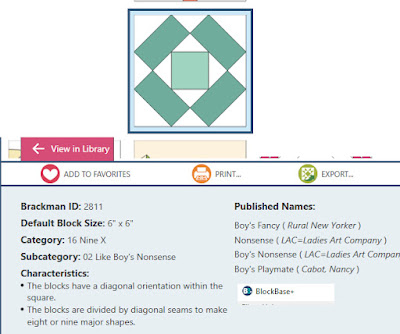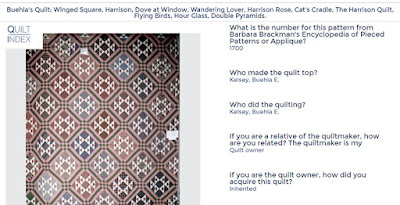use the number and people could communicate with the number.
Well, now you can.
And now there's a search box where you can type in the number (Brackman ID Number) and find all the quilts in that pattern.
If you try this in the Quilt Index you notice you get some false positives; for some reason some Wedding Rings come up as #1700.
(My father was a computer programmer in the 1960s and this is sort of how our dinner conversation went.)
The Quilt Index is a magnificent database, a project of Matrix: The Center for Digital Humanities & Social Sciences at Michigan State University, an open access, digital repository of images, stories and information about quilts and quiltmakers drawn from hundreds of public and private collections around the world.
Electric Quilt has published two versions of my idea, the computer
program BlockBase+ and the bound book Encyclopedia of Pieced
Quilt Patterns, both revised last year.
Every pattern (over 4,000) has a number.
Ducks in a row!
You can find the pattern, its relatives, its names and in BlockBase+
draw it any size.
But one more thing.
The Quilt Index.
One hundred thousand quilts are up there for quilt historians to look at and compare, for quiltmakers to obtain inspiration and for people waiting in the dentist's office to scroll through on their phones. It is an impressive tool.
So the other day Marsha McDowell and Beth Donaldson (the human beings behind the database) asked the Six Know-It-Alls if we'd make any changes to it.
See Six Know-It-Alls here:
(There were actually 7 of us offering advice---one is behind the quilt
like the Wizard of Oz.)
Not to be tooooo self-serving I brought up the point that many of the quilt projects and museums when entering their data looked up the number of each quilt in my Encyclopedia and wrote it on the form. What if you could search by that number: the Brackman number?
Beth said she could do it!
You look up the number in BlockBase+ or the book
Here we have #2811, Boy's Fancy, Boy's Nonsense, etc. 4 names in BlockBase+.
Type the number in the box.
Four projects wrote in that particular number on their forms and here
you have 4 quilts entered with various names, Boy's Nonsense
but also Multi-Colored Pattern and Block Sampler.
#1700 has more names: Nine.
You can look it up by number and find 40 hits:
Some with traditional names like Cat's Cradle or Harrison Rose
But some you'd never find without the number like "Nine Patch" or "Bobbie's Dresses."
Here's "Beuhla's Quilt."
See more about the Encyclopedia & BlockBase+
https://electricquilt.com/
And not every project or museum had a pattern fan who enjoyed going through the Encyclopedia to find the number.
But for me: It's a dream come true.
(I re-iterate, strange dreams for a 25 year old....)
One other improvement we suggested. The text used to be white letters on a dark blue background. We had a hard time reading it and it was a pain to copy text into another format. And Beth fixed that!
So there is a new interface, easier to read, less scrolling involved.
(One thing you have to do though to see the new format is Clear Your Browser for this site or you will see white text on a white ground. In other words: Nothing.)Thanks, Beth, for asking us what we'd change and for changing it!



















































